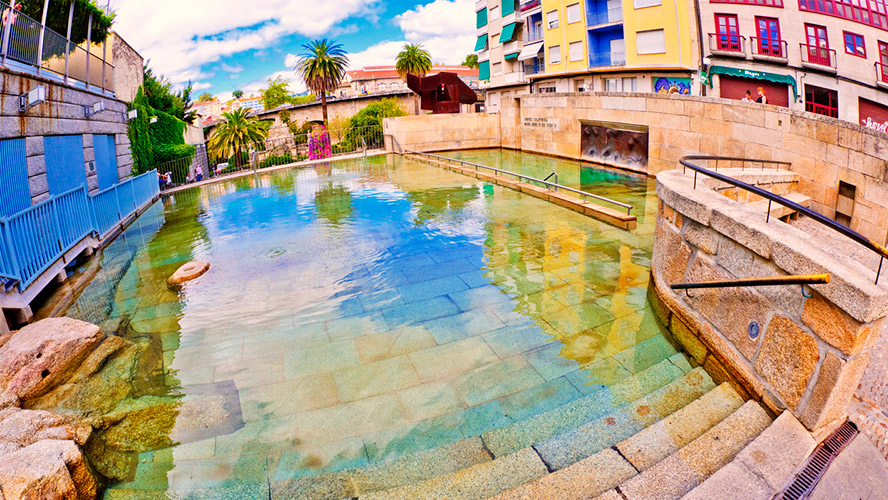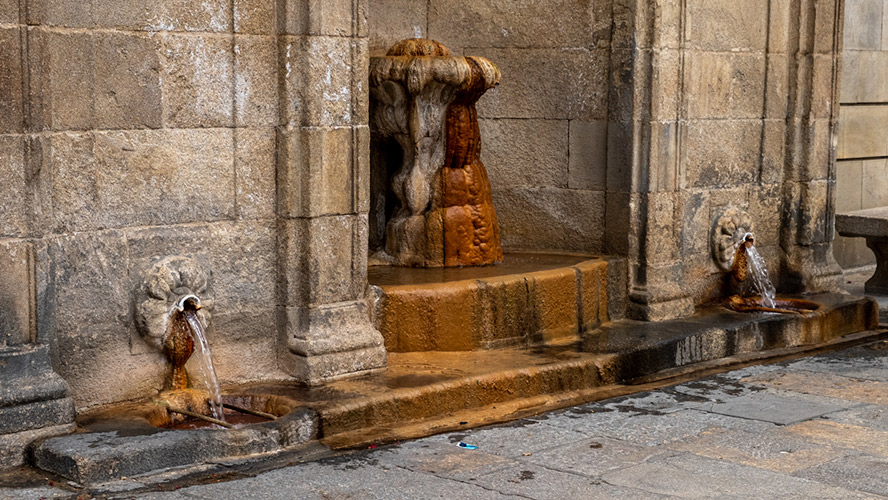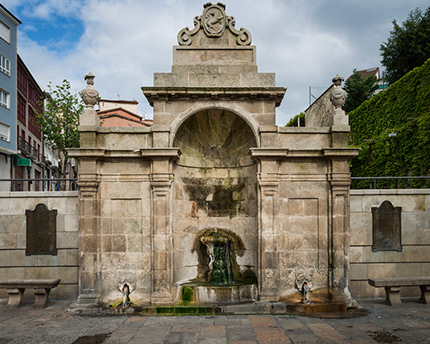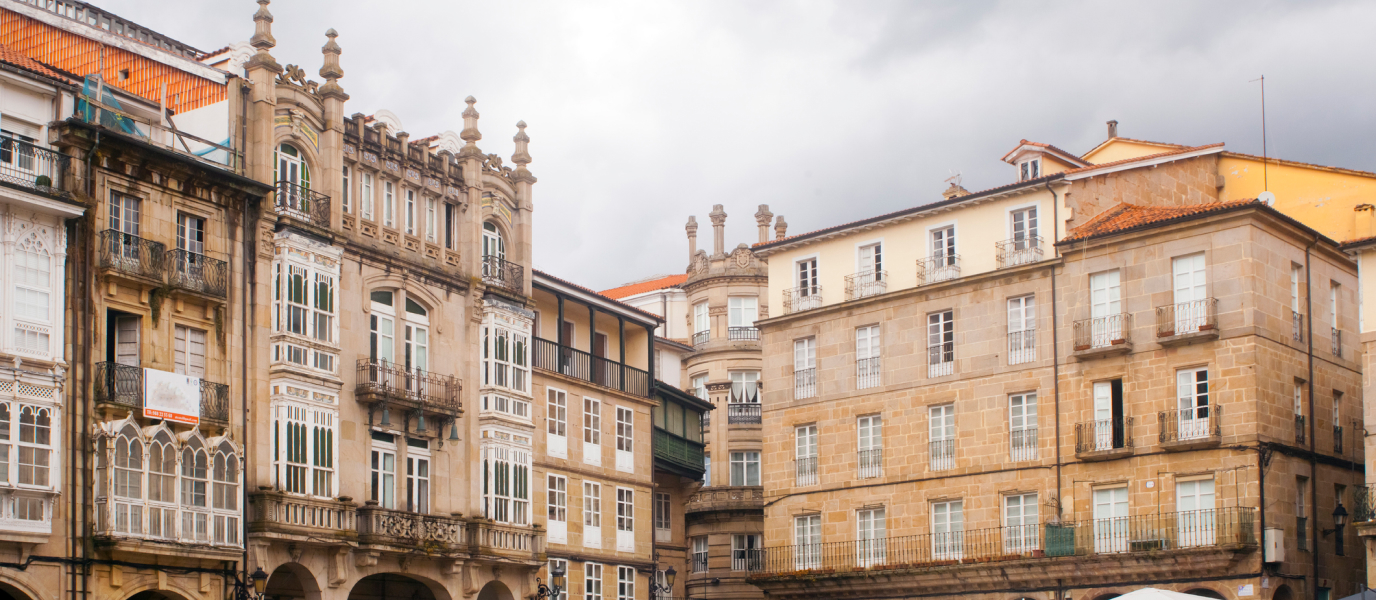The history of thermalism in Ourense is neither new nor a passing fad, but goes back thousands of years. It was the Romans, who were well aware of the benefits of therapeutic waters, who set up public architectural spaces to make use of them for health. Therefore, As Burgas, the first official hot springs, are a must when visiting the city.
In addition to visiting this historic site, you should also take the opportunity to explore the beautiful city centre, where it is advisable to combine visits to monuments and places as impressive as the Cathedral, with its Portico of Paradise, while strolling around the Plaza Mayor (Main Square), the Plaza del Trigo (Wheat Square) and the Plaza del Hierro (Iron Square), all of which are very pleasant. And, since not everything is walking, sit at any of the many outdoor seating areas scattered around the city to explore Ourense’s gastronomy, where there is no shortage of large empanada pies, pork shoulder with turnip greens, octopus and excellent Galician beef steaks. There is even an area called ‘Os Viños’ where it is common to try each bar’s speciality while tasting the local wines. We cannot think of a better plan.
History of As Burgas
An essential place to learn about the history of As Burgas and their link to the birth of Ourense is the Archaeological and Thermal Site Visitors’ Centre. This could be your first visit. There you will learn about the importance of As Burgas as an iconic place from the past to the present day. Precisely in the location of these springs is where it is believed that the city of Ourense may have been founded in Roman times, Aquis Auriensis, i.e. golden waters. However, more recent studies indicate that there are also other monuments from the same period (second half of the 1st century AD).
This does not mean that the hot springs were not used until the Romans, because it is known that the inhabitants of the pre-Roman hill forts already used them for practical and even recreational purposes. Nevertheless, it was during Roman times when architecture was given to it. The first remains found in the archaeological excavations at As Burgas are a pool-sanctuary from the 1st century AD and six valuable votive stones that mention Revve Anabaraego, a divinity who lived in the springs. Next to that sanctuary is a ‘balnea’, a typical bathhouse where they met to discuss their daily affairs.
In the Middle Ages, the springs were also useful for preventing disease and were used by pilgrims on their way to Santiago de Compostela. Even some of Ourense’s craft industries found their proximity useful to set up their workshops.

As Burgas springs
There is an interesting geological explanation for As Burgas since it is believed that the hot water comes from certain fault movements. Such earth movements would have allowed rainwater to seep into the Earth’s interior to a depth of about 2,000 metres. That is where the water heats up and gushes back up to the surface. The area of As Burgas was declared a Site of Cultural Interest in 2007 and has been fitted out for your enjoyment.
Spring water flows from the A Burga de Arriba spouts at a temperature of around 60ºC. It is the same water that fed the Roman sanctuary, i.e. the oldest and the one mentioned in some medieval documents. Although the monument is simple, it is of great historical value. Its water was once used to supply a washing place and even the municipal slaughterhouse.

Even more relevant is A Burga de Abaixo, a monument that symbolises Ourense’s old town. It is neoclassical in style and its design was inspired by the Roman places where nymphs were worshipped. The water flows through one of its pipes at more than 70ºC, which was used in the past to clean slaughtered animals.
Do not miss the beautiful garden of Nuestra Señora de As Burgas, dating from 1941 where the Virgin of Carmen is worshipped in an effort to Christianise the place and disassociate it from pagan practices.
As Burgas thermal pool
After learning about their history, the only thing left to do is try the waters and, to do so, we encourage you to visit the thermal pool located in the city’s historic centre. It is about 200m2 and can be used freely to experience first-hand the feeling of bathing surrounded by history. The pool water is cooled from the 60ºC at which it flows from the spring to 38-40ºC, making bathing a pleasant experience. This type of water is ideal for skin care and muscle relaxation thanks to its medium mineralisation, slightly alkaline and lithinic properties.
The bathing, which is free of charge, can be accompanied by a wet sauna or sunbathing on the terrace if the season is favourable. It is not suitable for people with hypertension, hypotension, heart problems or if pregnant. As it is under renovation, check to see if it is open during your trip.
Other hot springs in Ourense
Ourense has more than three thousand litres of thermal waters daily between As Burgas and the pool complex installed along the river Miño. You can also go to this last place because there are three free swimming pools with changing rooms, cafeterias, toilets, etc., as well as two privately managed thermal stations.
Where to stay in Ourense
An ideal place to sleep in this beautiful city is the Barceló Ourense, which is located next to the historic centre and San Lázaro Park, as it allows you to discover all its secrets comfortably on foot. We like everything about this four-star hotel, from its avant-garde feel to its comprehensive facilities. The comfortable B-Rooms, with snug mattresses, pillow menus, rain showers, and tea and coffee sets, are worth mentioning. After resting in one of those rooms and having a B-Likeat buffet breakfast, you will be ready to enjoy Ourense. Do not miss its fitness room, sauna, lobby bar or, if you are travelling on business, its meeting rooms.



















































































